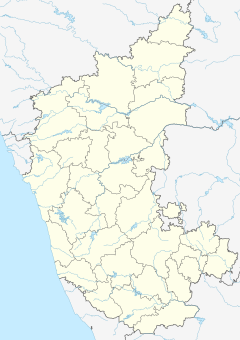
Venkateswara, Venkatachalapati, Balaji, or Srinivasa, is a form of the Hindu deity Vishnu and is the presiding deity of the Venkateshwara Temple, located in Tirupati, Andhra Pradesh, India. Venkateshwara is also known by various other names. The deity is worshiped by North Indians by the name 'Balaji'.

The Sri Venkateswara Swami Temple is a Hindu temple situated in the hills of Tirumala at Tirupati in Tirupati district of Andhra Pradesh, India. The temple is dedicated to Venkateswara, a form of Vishnu, who is believed to have appeared on the earth to save mankind from trials and troubles of Kali Yuga. Hence the place is also known by the name Kaliyuga Vaikuntha and the deity here is referred to as Kaliyuga Prathyaksha Daivam. The temple is also known by other names like Tirumala Temple, Tirupati Temple and Tirupati Balaji Temple. Venkateswara is known by many other names: Balaji, Govinda, and Srinivasa. The temple is run by Tirumala Tirupati Devasthanams (TTD), which is under control of Andhra Pradesh Government. The head of TTD is appointed by Andhra Pradesh Government. The temple is one of the Pancha Kshethram where Maha Lakshmi was born as Bhargavi - the daughter of Maharishi Bhrigu. The other four temples of the Pancha Kshethram are Sarangapani temple, Kumbakonam, Oppiliappan temple, Nachiyar Koil and Sundararaja Perumal Temple, Salem.

Vaikhanasa or Vaikhanasagama is a tradition of Hinduism that primarily worships Vishnu as the Supreme God. The tradition draws its name from the philosophy propounded by its founder, Sage Vikhanasa.
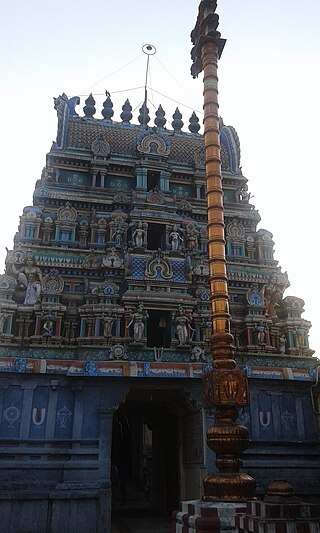
The Devaadi Raja Perumal temple in Therazhundur, a village in Mayiladuthurai district of the South Indian state of Tamil Nadu, is dedicated to the Hindu god Vishnu. Constructed in the Dravidian style of architecture, the temple is glorified in the Naalayira Divya Prabandham, the early medieval Tamil canon of the Alvar saints from the 6th–9th centuries CE. It is one of the 108 Divya Desams dedicated to Vishnu, who is worshipped as Amaruviappan, and his consort Lakshmi as Sengamalavalli Thayar. The original structure of the temple was built by the Karikala Chola during the 1st century CE, with later additions from the Cholas during the 11th century.

Nachiyar Kovil or Thirunarayur Nambi Temple is a Hindu temple in Thirunarayur, a village in the outskirts of Kumbakonam in the southern Indian state of Tamil Nadu, is dedicated to the Hindu god Vishnu and his wife Lakshmi. It is the sub urban region of business city of Kumbakonam.

Konetirayala Swamy Temple is a Hindu temple of Lord Venkateswara in the town of Keelapatla, Palamaner, Chittoor District, Andhra Pradesh, India.

The Purushotama Perumal Temple is located in Thirunangur, a village in the outskirts of Sirkazhi in the South Indian state of Tamil Nadu, and is dedicated to the Hindu god Vishnu. Constructed in the Dravidian style of architecture, the temple is glorified in the Nalayira Divya Prabandham, the early medieval Tamil canon of the Alvar saints from the 6th–9th centuries CE. It is one of the 108 Divya Desams dedicated to Vishnu, who is worshipped as Purushottaman and his consort Lakshmi as Purushottama Nayagi.
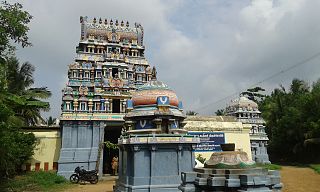
Thiruarimeya Vinnagaram or Kudamudakoothan Perumal Temple is dedicated to Hindu god Vishnu located in Tirunangur, a village in the outskirts of Sirkaḻi in the South Indian state of Tamil Nadu. Constructed in the Dravidian style of architecture, the temple is glorified in the Nalayira Divya Prabandham, the early medieval Tamil canon of the Alvar saints from the 6th–9th centuries CE. It is one of the 108 Divya Desams dedicated to Vishnu, who is worshipped as Kudamudakoothan and his consort Lakshmi as Amirtagadavalli.
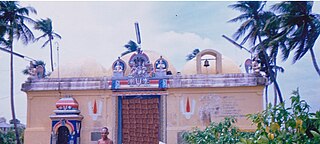
Thiruvaikunda Vinnagaram or Vaikunta Nathan Perumal Temple is dedicated to Hindu god Vishnu located in Tirunangur, a village in the outskirts of Sirkazhi in the South Indian state of Tamil Nadu. Constructed in the Dravidian style of architecture, the temple is glorified in the Nalayira Divya Prabandham, the early medieval Tamil canon of the Alvar saints from the 6th–9th centuries CE. It is one of the 108 Divya Desams dedicated to Vishnu, who is worshipped as Vaikuntanathan and his consort Lakshmi as Vaikuntavalli.

Thirumanimadam or Narayanan Perumal Temple is dedicated to Hindu god Vishnu located in Thirunangur, a village in the outskirts of Sirkazhi in the South Indian state of Tamil Nadu. Constructed in the Dravidian style of architecture, the temple is glorified in the Nalayira Divya Prabandham, the early medieval Tamil canon of the Alvar saints from the 6th–9th centuries CE. It is one of the 108 Divya Desams dedicated to Vishnu, who is worshipped as Narayanan and his consort Lakshmi as Pundarikavalli.

Thiruthevanartthogai or Madhava Perumal Temple is a Hindu temple dedicated to Vishnu located in Tirunangur, a village in the outskirts of Sirkaḻi in the South Indian state of Tamil Nadu. Constructed in the Dravidian style of architecture, the temple is glorified in the Nalayira Divya Prabandham, the early medieval Tamil canon of the Alvar saints from the 6th–9th centuries CE. It is one of the 108 Divya Desams dedicated to Vishnu, who is worshipped as Madhava Perumal and his consort Lakshmi as Kadalmagal.

Thiruthetriyambalam or Palli Konda Perumal Temple is located in Tirunangur, a village in the outskirts of Sirkaḻi in the South Indian state of Tamil Nadu, is dedicated to the Hindu god Vishnu. Constructed in the Dravidian style of architecture, the temple is glorified in the Nalayira Divya Prabandham, the early medieval Tamil canon of the Alvar saints from the 6th–9th centuries CE. It is one of the 108 Divya Desams dedicated to Vishnu, who is worshipped as Palli Konda Perumal.

Thirumanikkoodam or Varadaraja Perumal Temple is located in Thirunangur, a village in the outskirts of Sirkaḻi in the South Indian state of Tamil Nadu. It is dedicated to the Hindu god Vishnu. Constructed in the Dravidian style of architecture, the temple is glorified in the Nalayira Divya Prabandham, the early medieval Tamil canon of the Alvar saints from the 6th–9th centuries CE. It is one of the 108 Divya Desams dedicated to Vishnu, who is worshipped as Varadharaja Perumal.
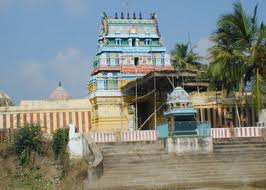
Thiruvellakkulam is a Hindu temple dedicated to Vishnu located in Thirunangur, a village in the outskirts of Sirkazhi in the South Indian state of Tamil Nadu. Constructed in the Dravidian style of architecture, the temple is glorified in the Nalayira Divya Prabandham, the early medieval Tamil canon of the Alvar saints from the 6th–9th centuries CE. It is one of the 108 Divya Desams dedicated to Vishnu, who is worshipped as Annan Perumal and his consort Lakshmi as Alamermangai.
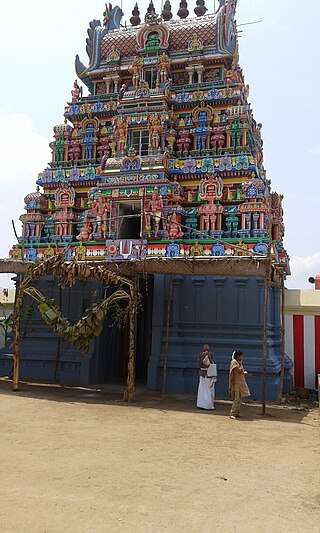
The Taamaraiyaal Kelvan Perumal Temple or Thiruppaarththanpalli is located close to Thirunangur, a small village, 8 km east of Sirkali en route to Thiruvenkadu and is dedicated to the Hindu god Vishnu. Constructed in the Dravidian style of architecture, the temple is glorified in the Nalayira Divya Prabandham, the early medieval Tamil canon of the Alvar saints from the 6th–9th centuries CE. It is one of the 108 Divya Desams dedicated to Vishnu, who is worshipped as Taamariyaal Kelvan and his consort Lakshmi as Shegamalavalli.
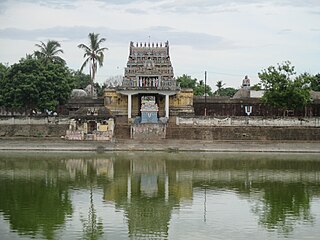
The Bhaktavatsala Perumal Temple is a temple dedicated to Hindu god Vishnu, located in Thirukannamangai, a village in Tiruvarur district in the South Indian state of Tamil Nadu. Constructed in Dravidian style of architecture, the temple is glorified in the Nalayira Divya Prabandham, the early medieval Tamil canon of the Alvar saints from the 6th–9th centuries CE. It is counted as one among the 108 Divya Desams dedicated to Vishnu. Vishnu is worshipped as Bhaktavatsala Perumal and his consort Lakshmi as Kannamangai Nayagi.
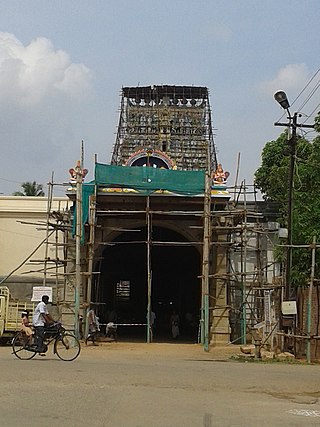
The Vanamamalai Perumal Temple, also known as Arulmigu Sree Vanamamalai Totatri Perumal Temple is a Hindu temple dedicated to the god Vishnu, in Vanamamalai or Totadrikshetram (Nanguneri), Tamil Nadu, India on the banks of Thamiraparani river. Constructed in the Dravidian style of architecture, the temple is glorified in the Nalayira Divya Prabandham, the early medieval Tamil canon of the Alvar saints from the 6th–9th centuries CE. It is one of the 108 Divya Desams shrines dedicated to Vishnu. Vishnu is worshipped here as Vanamalai Perumal and his consort Lakshmi as Varamanagi. The temple is believed to have been built by the Pandyas, with later contributions from Vijayanagara kings and Madurai Nayaks. The temple covers an area of 5 acres (20,000 m2) and has a five-tiered temple tower.

The Makara Nedunkuḻaikathar Temple is one of the Nava Tirupathi, nine Hindu temples dedicated to Vishnu located Thenthiruperai along Tiruchendur-Tirunelveli route, Tamil Nadu, India in the southern bank of Thamiraparani river. It is located 5 km from Alvar Thirunagari All these 9 temples are classified as Divya Desams, the 108 temples of Vishnu revered by the 12 poet saints, or Alvars. The temple is referred to as Sukra sthalam, a location for the planet deity, Sukra. Constructed in the Dravidian style of architecture, the temple is glorified in the Nalayira Divya Prabandham, the early medieval Tamil canon of the Alvar saints from the 6th–9th centuries CE. It is one of the 108 Divya Desams dedicated to Vishnu, who is worshipped as Makara Nedunkuḻaikathar and his consort Lakshmi as Tiruperai Nachiyar.

The Alagiyasingar Temple in Thiruvali, a village in Mayiladuthurai district in the South Indian state of Tamil Nadu, is dedicated to the Hindu god Vishnu. Constructed in the Dravidian style of architecture, the temple is glorified in the Nalayira Divya Prabandham, the early medieval Tamil canon of the Alvar saints from the 6th–9th centuries CE. It is one of the 108 Divya Desams dedicated to Vishnu, who is worshipped as Alagiyasingar and his consort Lakshmi as Purnavalli.

Sri Govindarajaswamy Temple is an ancient Hindu Vaishnavite temple situated in the heart of Tirupati city in Tirupati district of Andhra Pradesh in India. The temple was built during 12th century and was consecrated in the year 1130 AD by Ramanuja. The temple is one of the earliest structures in Tirupati and also one of the biggest temple complexes in the district. The Tirupati city is built around this temple. The temple is currently administered by Tirumala Tirupati Devasthanams.

